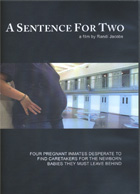
A Sentence for Two 2008
Distributed by Fanlight Productions, 4196 Washington, Suite 2, Boston, MA 02131; 800-937-4113
Produced by Randi Jacobs
Directed by Randi Jacobs
DVD, color, 58 min.
Sr. High - Adult
Social Work, Criminology, Political Science, Sociology, Women's Studies
Date Entered: 02/22/2010
Reviewed by Ciara Healy, Technical Services Librarian, Polk Library, University of Wisconsin-OshkoshCoffee Creek Correctional facility in Lane County, Oregon is the setting for the film A Sentence for Two which focuses on 4 women who are incarcerated while pregnant. Overall, the film sets up a contrast between prison systems that allow women to care for their children in the confines of a prison, and women who must find family members or foster or adoptive parents for their newborns. Coffee Creek is a facility that is exploring the possibility of having a nursery program on site. Throughout the course of the film the women give birth and the outcomes of their respective decisions are shown. Also interviewed are a judge, mental health care providers, obstetricians and child psychologists that work in the corrections system.
The four women interviewed, most are in prison on drug related charges and identity theft, and are serving sentences up to 36 months. All arrived in Coffee Creek at varying stages of their pregnancies. The personal narratives offered are rough, as most of the women were survivors of mental, physical and sexual abuse and have also become drug addicts, turning to crime to support their addiction. In prison, the women are off drugs and the interviews are all the more gripping because of the bleak circumstances that they are dealing with. Most also have older children who are currently with various family members, adopted or fostered with the Department of Human Services (DHS).
The options that exist for pregnant women in this situation include adoption, placement of the infant with a family member or fostered with DHS. Abortion is an option for pregnant inmates, but they must pay for it themselves. The prenatal care and birth are paid for by the county and can cost thousands of dollars. Of the women interviewed, different options were chosen, some details not being settled until the time of birth. Length of the sentence can also make a difference to parental rights, further complicating the existing options. After the women give birth, they are interviewed about the experience – giving birth with guards present, staying the hospital for six hours before returning to prison – and all report the difficulty of giving up their children in to a variety of caregivers, even though they prepared for that eventuality.
In contrast, service providers in a prison system where inmates can care for their children are interviewed. In an interview with a child psychologist studying children born to inmates, the doctor focuses on attachment, child development, nursing care and recidivism. According to her research, the babies in the program reach their normal developmental milestones and the inmates have an attachment that is significant for them, motivating them to have good behavior and look forward to the life with their children at the end of their sentences.
This film would work well for in-class viewings in courses such as social work, criminology, political science, sociology and women’s studies.